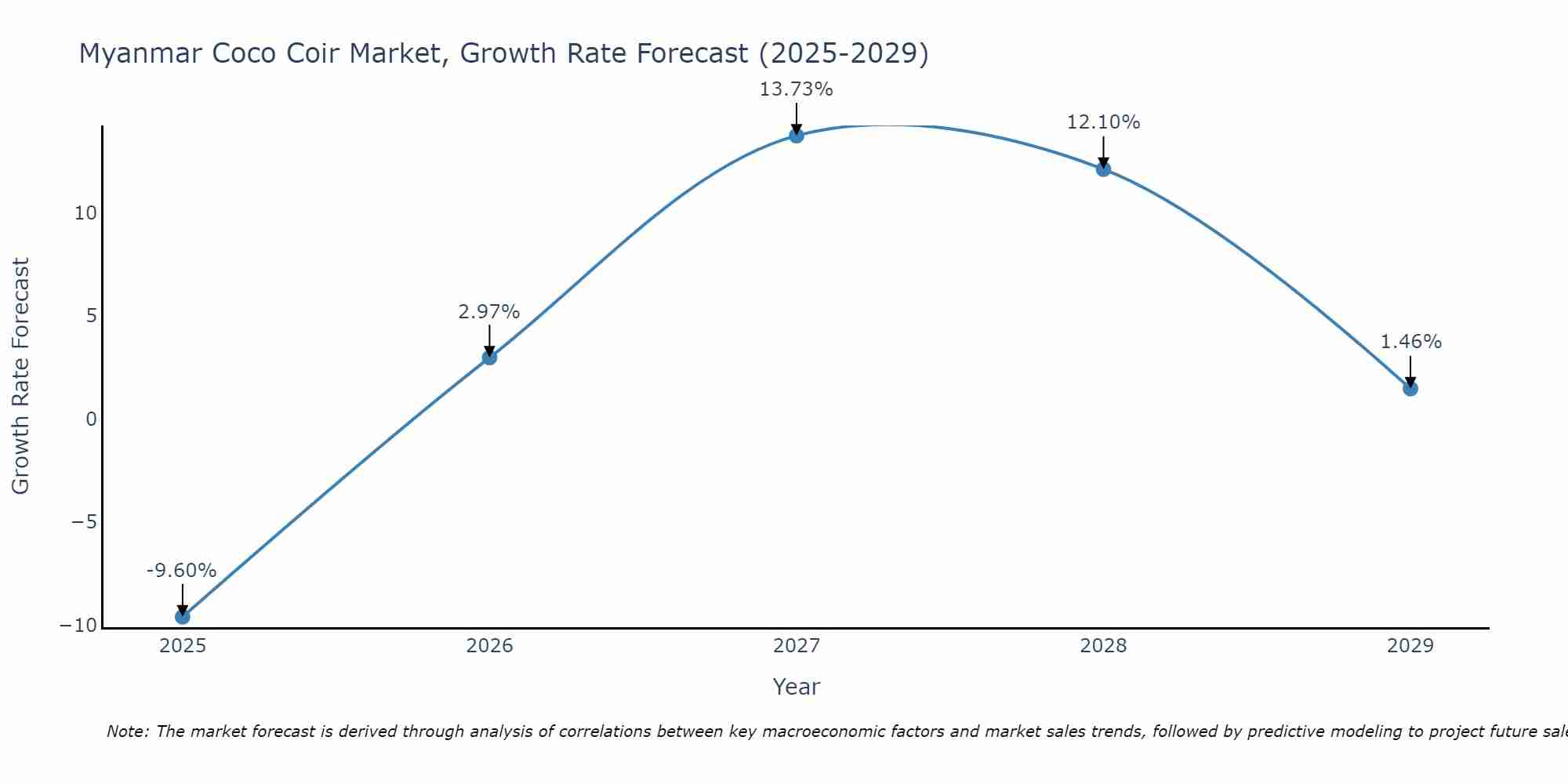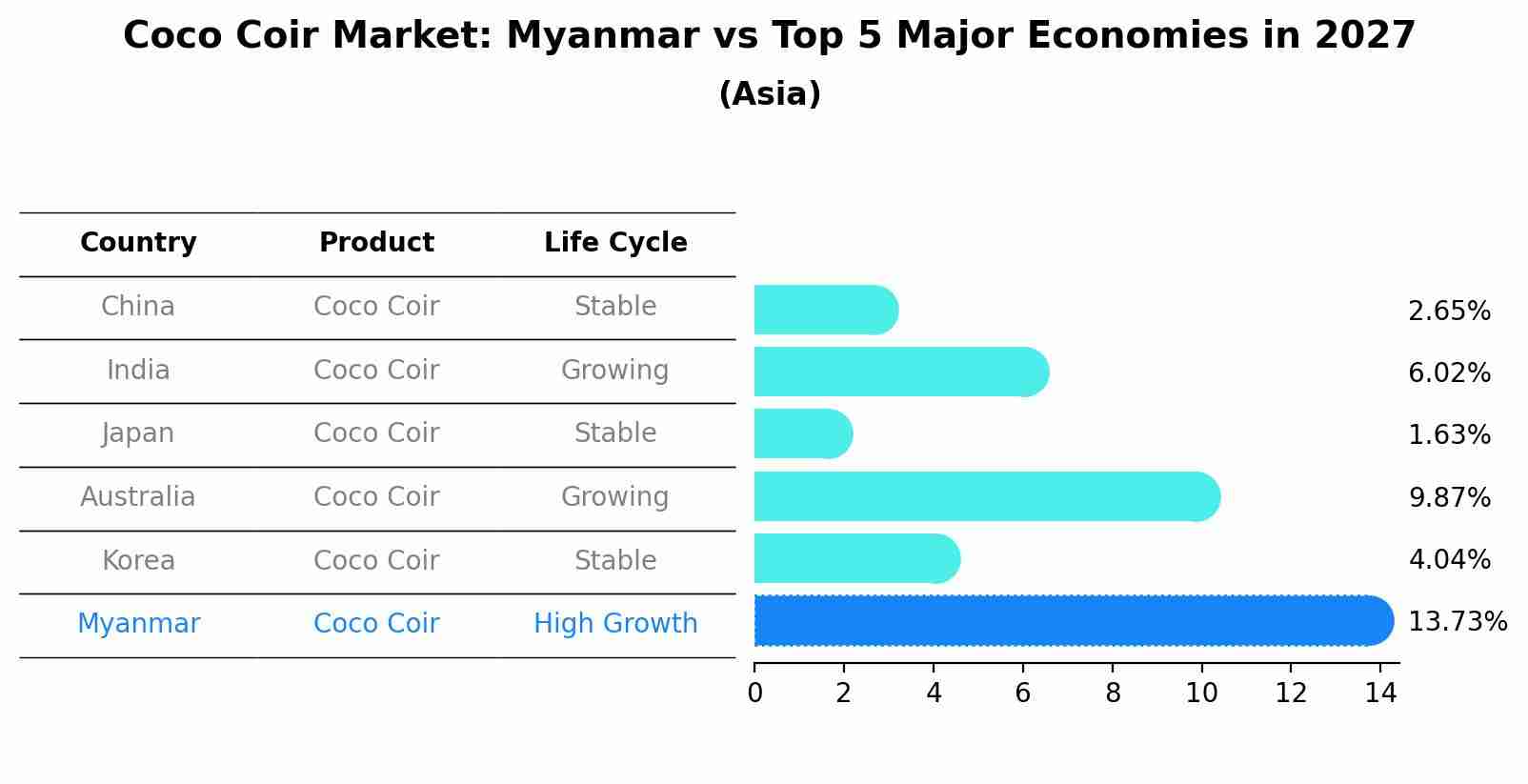Myanmar Coco Coir Market Outlook | Value, Growth, Analysis, Trends, Forecast, Revenue, Industry, Share, Companies, COVID-19 IMPACT & Size
| Product Code: ETC373714 | Publication Date: Aug 2022 | Updated Date: Jul 2025 | Product Type: Market Research Report | |
| Publisher: 6Wresearch | Author: Dhaval Chaurasia | No. of Pages: 75 | No. of Figures: 35 | No. of Tables: 20 |
Myanmar Coco Coir Market Size Growth Rate
The Myanmar Coco Coir Market is projected to witness mixed growth rate patterns during 2025 to 2029. Starting at -9.60% in 2025, the market peaks at 13.73% in 2027, and settles at 1.46% by 2029.

Coco Coir Market: Myanmar vs Top 5 Major Economies in 2027 (Asia)
By 2027, Myanmar's Coco Coir market is forecasted to achieve a high growth rate of 13.73%, with China leading the Asia region, followed by India, Japan, Australia and South Korea.

Myanmar Coco Coir Market Synopsis
The Myanmar Coco Coir market is experiencing steady growth driven by increasing awareness of sustainable and eco-friendly agricultural practices. Coco coir, derived from coconut husks, is utilized as a natural alternative to traditional peat moss due to its superior water retention and aeration properties. The market is primarily driven by the agriculture sector, where coco coir is widely used in greenhouse cultivation, hydroponic systems, and soil conditioning. Additionally, the growing demand for organic and chemical-free products in Myanmar is further propelling the market growth. Key market players are focusing on product innovation, quality enhancement, and strategic partnerships to strengthen their market position. The government`s support for agricultural development and emphasis on environmental sustainability are also contributing factors to the positive outlook of the Myanmar Coco Coir market.
Myanmar Coco Coir Market Trends
The Myanmar Coco Coir market is experiencing a growing trend towards sustainable and eco-friendly products, with coir being a popular choice due to its biodegradability and renewable nature. The demand for coco coir products, such as growing mediums, mulch, and soil amendments, is increasing in the agriculture and horticulture sectors as farmers and gardeners seek organic and chemical-free alternatives. Additionally, the rise in urban gardening and indoor plant cultivation is driving the sales of coco coir products as it is lightweight, easy to use, and promotes healthy plant growth. Manufacturers in Myanmar are focusing on product innovation, quality control, and expanding distribution channels to meet the rising demand for coco coir both domestically and internationally.
Myanmar Coco Coir Market Challenges
In the Myanmar Coco Coir market, the main challenges include limited awareness and understanding of the benefits of coco coir among potential customers, lack of advanced technology for production and processing, inconsistent quality standards leading to varying product quality, and limited access to export markets due to international regulations and competition. Additionally, the industry faces constraints in terms of infrastructure, transportation, and access to finance, hindering its growth potential. Overcoming these challenges will require increased investment in technology and infrastructure, as well as efforts to educate consumers and improve quality control measures to enhance competitiveness in both domestic and international markets.
Myanmar Coco Coir Market Investment Opportunities
The Myanmar Coco Coir Market presents promising investment opportunities due to the increasing global demand for eco-friendly and sustainable alternatives to traditional growing mediums. As a byproduct of the coconut industry, coco coir offers excellent water retention and aeration properties, making it ideal for use in agriculture, horticulture, landscaping, and erosion control applications. With Myanmar being one of the world`s largest coconut producers, the availability of raw materials is abundant, providing a competitive advantage in terms of cost and supply chain efficiency. Investing in the manufacturing, processing, and export of coco coir products in Myanmar can capitalize on the growing trend towards organic and environmentally friendly products, catering to a diverse range of industries both domestically and internationally.
Jordan Agar Market Government Policies
Government policies related to the Myanmar Coco Coir Market focus on promoting sustainable agricultural practices and supporting the growth of the coir industry. The government has implemented initiatives to provide subsidies and incentives for farmers to adopt coco coir as a growing medium, encouraging the use of natural and eco-friendly materials in agriculture. Additionally, regulations are in place to ensure the quality and safety of coco coir products, aiming to enhance the reputation of Myanmar`s coir industry in both domestic and international markets. The government also supports research and development efforts to improve production techniques and increase the competitiveness of the coco coir market. Overall, government policies in Myanmar are geared towards fostering a thriving and environmentally-conscious coco coir industry.
Myanmar Coco Coir Market Future Outlook
The Myanmar coco coir market is expected to show steady growth in the coming years due to increasing awareness about sustainable agricultural practices and the rising demand for organic products. The country`s favorable climate conditions for coconut cultivation further support the growth of the coco coir industry. Additionally, the expanding application of coco coir in various sectors such as agriculture, horticulture, and landscaping is projected to drive market growth. However, challenges such as limited awareness among farmers about the benefits of coco coir and infrastructural constraints may hinder the market`s full potential. Overall, with the increasing focus on environmentally friendly alternatives and the growing agricultural sector in Myanmar, the coco coir market is anticipated to witness positive growth prospects in the foreseeable future.
Key Highlights of the Report:
- Myanmar Coco Coir Market Outlook
- Market Size of Myanmar Coco Coir Market, 2021
- Forecast of Myanmar Coco Coir Market, 2031
- Historical Data and Forecast of Myanmar Coco Coir Revenues & Volume for the Period 2018 - 2031
- Myanmar Coco Coir Market Trend Evolution
- Myanmar Coco Coir Market Drivers and Challenges
- Myanmar Coco Coir Price Trends
- Myanmar Coco Coir Porter's Five Forces
- Myanmar Coco Coir Industry Life Cycle
- Historical Data and Forecast of Myanmar Coco Coir Market Revenues & Volume By Product for the Period 2018 - 2031
- Historical Data and Forecast of Myanmar Coco Coir Market Revenues & Volume By Coco Coir Grow Bags for the Period 2018 - 2031
- Historical Data and Forecast of Myanmar Coco Coir Market Revenues & Volume By Bales for the Period 2018 - 2031
- Historical Data and Forecast of Myanmar Coco Coir Market Revenues & Volume By Coir Material for the Period 2018 - 2031
- Historical Data and Forecast of Myanmar Coco Coir Market Revenues & Volume By Open Tops for the Period 2018 - 2031
- Historical Data and Forecast of Myanmar Coco Coir Market Revenues & Volume By Blends & Loose Substrate for the Period 2018 - 2031
- Historical Data and Forecast of Myanmar Coco Coir Market Revenues & Volume By Others for the Period 2018 - 2031
- Historical Data and Forecast of Myanmar Coco Coir Market Revenues & Volume By Application for the Period 2018 - 2031
- Historical Data and Forecast of Myanmar Coco Coir Market Revenues & Volume By Rope & Cordage for the Period 2018 - 2031
- Historical Data and Forecast of Myanmar Coco Coir Market Revenues & Volume By Coco Nets & Twines for the Period 2018 - 2031
- Historical Data and Forecast of Myanmar Coco Coir Market Revenues & Volume By Stitched Mats for the Period 2018 - 2031
- Historical Data and Forecast of Myanmar Coco Coir Market Revenues & Volume By Coconut Meals for the Period 2018 - 2031
- Historical Data and Forecast of Myanmar Coco Coir Market Revenues & Volume By Husk for the Period 2018 - 2031
- Historical Data and Forecast of Myanmar Coco Coir Market Revenues & Volume By Others for the Period 2018 - 2031
- Historical Data and Forecast of Myanmar Coco Coir Market Revenues & Volume By Consumer for the Period 2018 - 2031
- Historical Data and Forecast of Myanmar Coco Coir Market Revenues & Volume By Green Houses for the Period 2018 - 2031
- Historical Data and Forecast of Myanmar Coco Coir Market Revenues & Volume By Sellers for the Period 2018 - 2031
- Myanmar Coco Coir Import Export Trade Statistics
- Market Opportunity Assessment By Product
- Market Opportunity Assessment By Application
- Market Opportunity Assessment By Consumer
- Myanmar Coco Coir Top Companies Market Share
- Myanmar Coco Coir Competitive Benchmarking By Technical and Operational Parameters
- Myanmar Coco Coir Company Profiles
- Myanmar Coco Coir Key Strategic Recommendations
Frequently Asked Questions About the Market Study (FAQs):
- Single User License$ 1,995
- Department License$ 2,400
- Site License$ 3,120
- Global License$ 3,795
Search
Related Reports
- Portugal Electronic Document Management Market (2025-2031) | Strategy, Consumer Insights, Analysis, Investment Trends, Opportunities, Growth, Size, Share, Industry, Revenue, Segments, Value, Segmentation, Supply, Forecast, Restraints, Outlook, Competition, Drivers, Trends, Demand, Pricing Analysis, Competitive, Strategic Insights, Companies, Challenges
- France Electronic Document Management Market (2025-2031) | Strategy, Consumer Insights, Analysis, Investment Trends, Opportunities, Growth, Size, Share, Industry, Revenue, Segments, Value, Segmentation, Supply, Forecast, Restraints, Outlook, Competition, Drivers, Trends, Demand, Pricing Analysis, Competitive, Strategic Insights, Companies, Challenges
- Portugal Occupational Health & Safety Services Market (2025-2031) | Strategy, Consumer Insights, Analysis, Investment Trends, Opportunities, Growth, Size, Share, Industry, Revenue, Segments, Value, Segmentation, Supply, Forecast, Restraints, Outlook, Competition, Drivers, Trends, Demand, Pricing Analysis, Competitive, Strategic Insights, Companies, Challenges
- Netherlands Occupational Health and Safety Services Market (2025-2031) | Strategy, Consumer Insights, Analysis, Investment Trends, Opportunities, Growth, Size, Share, Industry, Revenue, Segments, Value, Segmentation, Supply, Forecast, Restraints, Outlook, Competition, Drivers, Trends, Demand, Pricing Analysis, Competitive, Strategic Insights, Companies, Challenges
- Belgium and Luxembourg Facility Management Market (2025-2031) | Strategy, Consumer Insights, Analysis, Investment Trends, Opportunities, Growth, Size, Share, Industry, Revenue, Segments, Value, Segmentation, Supply, Forecast, Restraints, Outlook, Competition, Drivers, Trends, Demand, Pricing Analysis, Competitive, Strategic Insights, Companies, Challenges
- Russia Women Intimate Apparel Market (2025-2031) | Strategy, Consumer Insights, Analysis, Investment Trends, Opportunities, Growth, Size, Share, Industry, Revenue, Segments, Value, Segmentation, Supply, Forecast, Restraints, Outlook, Competition, Drivers, Trends, Demand, Pricing Analysis, Competitive, Strategic Insights, Companies, Challenges
- Africa Chocolate Market (2025-2031) | Size, Share, Trends, Growth, Revenue, Analysis, Forecast, industry & Outlook
- Global Hydroxychloroquine And Chloroquine Market (2025-2031) | Industry, Trends, Size, Outlook, Growth, Value, Companies, Revenue, Analysis, Share, Forecast
- Saudi Arabia Plant Maintenance Market (2025-2031) | Industry, Size, Growth, Revenue, Value, Companies, Forecast, Analysis, Share & Trends
- Taiwan Electric Truck Market (2025-2031) | Outlook, Industry, Revenue, Size, Forecast, Growth, Analysis, Share, Companies, Value & Trends
Industry Events and Analyst Meet
Our Clients
Whitepaper
- Middle East & Africa Commercial Security Market Click here to view more.
- Middle East & Africa Fire Safety Systems & Equipment Market Click here to view more.
- GCC Drone Market Click here to view more.
- Middle East Lighting Fixture Market Click here to view more.
- GCC Physical & Perimeter Security Market Click here to view more.
6WResearch In News
- Doha a strategic location for EV manufacturing hub: IPA Qatar
- Demand for luxury TVs surging in the GCC, says Samsung
- Empowering Growth: The Thriving Journey of Bangladesh’s Cable Industry
- Demand for luxury TVs surging in the GCC, says Samsung
- Video call with a traditional healer? Once unthinkable, it’s now common in South Africa
- Intelligent Buildings To Smooth GCC’s Path To Net Zero













